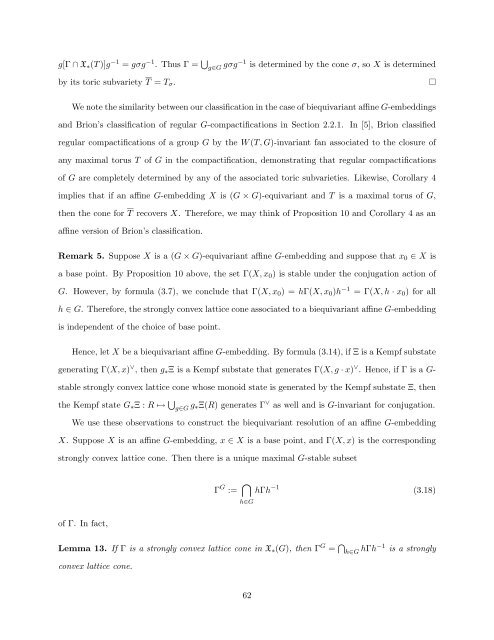Equivariant Embeddings of Algebraic Groups
Equivariant Embeddings of Algebraic Groups
Equivariant Embeddings of Algebraic Groups
Create successful ePaper yourself
Turn your PDF publications into a flip-book with our unique Google optimized e-Paper software.
g[Γ ∩ X ∗ (T )]g −1 = gσg −1 . Thus Γ = ⋃ g∈G gσg−1 is determined by the cone σ, so X is determined<br />
by its toric subvariety T = T σ .<br />
We note the similarity between our classification in the case <strong>of</strong> biequivariant affine G-embeddings<br />
and Brion’s classification <strong>of</strong> regular G-compactifications in Section 2.2.1. In [5], Brion classified<br />
regular compactifications <strong>of</strong> a group G by the W (T, G)-invariant fan associated to the closure <strong>of</strong><br />
any maximal torus T <strong>of</strong> G in the compactification, demonstrating that regular compactifications<br />
<strong>of</strong> G are completely determined by any <strong>of</strong> the associated toric subvarieties. Likewise, Corollary 4<br />
implies that if an affine G-embedding X is (G × G)-equivariant and T is a maximal torus <strong>of</strong> G,<br />
then the cone for T recovers X. Therefore, we may think <strong>of</strong> Proposition 10 and Corollary 4 as an<br />
affine version <strong>of</strong> Brion’s classification.<br />
Remark 5. Suppose X is a (G × G)-equivariant affine G-embedding and suppose that x 0 ∈ X is<br />
a base point. By Proposition 10 above, the set Γ(X, x 0 ) is stable under the conjugation action <strong>of</strong><br />
G. However, by formula (3.7), we conclude that Γ(X, x 0 ) = hΓ(X, x 0 )h −1 = Γ(X, h · x 0 ) for all<br />
h ∈ G. Therefore, the strongly convex lattice cone associated to a biequivariant affine G-embedding<br />
is independent <strong>of</strong> the choice <strong>of</strong> base point.<br />
Hence, let X be a biequivariant affine G-embedding. By formula (3.14), if Ξ is a Kempf substate<br />
generating Γ(X, x) ∨ , then g ∗ Ξ is a Kempf substate that generates Γ(X, g · x) ∨ . Hence, if Γ is a G-<br />
stable strongly convex lattice cone whose monoid state is generated by the Kempf substate Ξ, then<br />
the Kempf state G ∗ Ξ : R ↦→ ⋃ g∈G g ∗Ξ(R) generates Γ ∨ as well and is G-invariant for conjugation.<br />
We use these observations to construct the biequivariant resolution <strong>of</strong> an affine G-embedding<br />
X. Suppose X is an affine G-embedding, x ∈ X is a base point, and Γ(X, x) is the corresponding<br />
strongly convex lattice cone. Then there is a unique maximal G-stable subset<br />
Γ G := ⋂<br />
hΓh −1 (3.18)<br />
<strong>of</strong> Γ. In fact,<br />
h∈G<br />
Lemma 13. If Γ is a strongly convex lattice cone in X ∗ (G), then Γ G = ⋂ h∈G hΓh−1 is a strongly<br />
convex lattice cone.<br />
62
















